Horse blanketing is a key aspect of equine care, ensuring comfort and protection. Factors like climate, coat type, and living conditions determine the need. Turnout blankets, sheets, and coolers provide essential coverage for varying weather, while proper fit and weight selection are crucial for your horse’s well-being.
Factors to Consider When Blanketing
Climate, temperature, coat type, living conditions, and individual needs are critical. Ensure blankets are waterproof, avoid overheating, and fit properly to prevent discomfort and health issues for your horse.
Climate and Temperature
Climate and temperature play a significant role in determining your horse’s blanketing needs. In colder regions, heavier blankets are essential to protect against harsh winds and freezing temperatures. In milder climates, lightweight options may suffice. Always consider the specific weather conditions your horse will be exposed to, ensuring the blanket provides adequate protection without causing overheating. Waterproofing is crucial in rainy or snowy areas to keep your horse dry and warm. Monitoring temperature fluctuations helps in choosing the right weight and type of blanket, ensuring your horse remains comfortable and healthy throughout the season.
Horse’s Coat Type
A horse’s coat type significantly influences blanketing decisions. Horses with a thick, natural winter coat typically require less heavy blanketing, while those with a clipped or thinner coat may need more protection. A natural coat provides excellent insulation, but extreme cold or wet conditions may still necessitate a waterproof blanket. Clipped horses, especially those in consistent work, often rely on blankets to stay warm, as their coat is shorter and less insulating. Understanding your horse’s coat type helps tailor blanketing to their specific needs, ensuring comfort and preventing overheating. Always consider how their coat naturally regulates temperature and adjust blanketing accordingly to maintain their well-being.
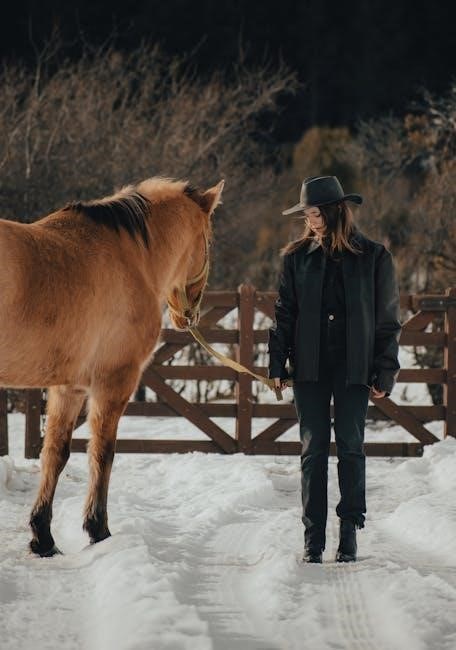
Living Conditions
Living conditions play a crucial role in determining your horse’s blanketing needs. Horses kept outdoors with access to shelter may require heavier blankets to protect against wind, rain, and cold. Those in stalls with adequate ventilation might need lighter options to prevent overheating. If your horse is exposed to harsh weather, such as heavy rain or freezing temperatures, a waterproof and breathable turnout blanket is essential. Conversely, horses in warmer or more protected environments may only need a lightweight sheet or no blanket at all. Additionally, horses with access to indoor facilities may require less heavy blanketing compared to those living entirely outdoors. Always assess the specific environment your horse is in to choose the most suitable blanket for their comfort and protection.
Individual Needs
Each horse has unique requirements when it comes to blanketing, making it essential to tailor your approach to their specific needs. Age, health conditions, and body type are key factors to consider. For example, older horses or those with medical conditions may need extra warmth, while younger, healthier horses might require less. Horses with a naturally thick coat may need lighter blankets, whereas those with a thinner coat or clipped hair may require heavier options. Additionally, horses that are underweight or have a higher metabolism might benefit from more insulation to stay warm. Always observe your horse’s behavior and physical condition to ensure the blanket is neither too heavy nor too light. Checking for signs of overheating, such as sweating, and ensuring proper fit are crucial for their comfort and well-being. Tailoring your blanketing strategy to your horse’s individual needs ensures optimal protection and comfort year-round.
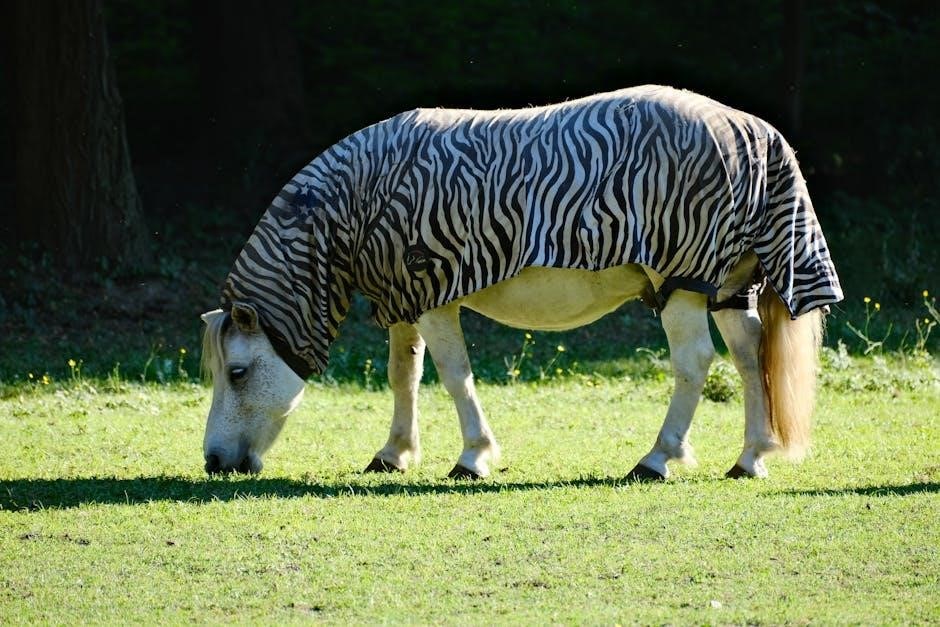
Types of Horse Blankets
Horse blankets include turnout blankets, sheets, lightweight options, and coolers. Each type serves specific purposes, from shielding against harsh weather to providing post-exercise cooling, ensuring comfort and protection for various needs.
Turnout Blankets
Turnout blankets are designed for outdoor use, providing protection from wind, rain, and cold. They are typically waterproof and breathable, ensuring your horse stays dry and comfortable. Available in various weights, such as 150g to 400g, these blankets are ideal for colder climates. The weight selection depends on your horse’s needs, climate, and living conditions. Turnout blankets often feature adjustable neck covers and belly straps for a secure fit. They are a must-have for horses living in harsh weather conditions, as they prevent chilling and discomfort. Proper fit is essential to avoid restricting movement or causing irritation. Always choose a turnout blanket that aligns with your horse’s specific requirements and the local weather patterns. This ensures optimal protection and comfort during outdoor activities or paddock time.
Sheets and Lightweight Blankets
Sheets and lightweight blankets are ideal for milder weather or horses that don’t require heavy protection. They are typically used in temperatures between 40°F and 50°F and are perfect for horses with clipped coats or those living in warmer climates; These blankets are designed to provide a light layer of coverage without trapping excessive heat, making them breathable and comfortable. They are often made from durable, water-resistant materials like polyester or nylon, ensuring your horse stays dry and protected from wind or light rain. Lightweight blankets are versatile and can be used both indoors and outdoors, offering a practical solution for transitional weather. They are also a great option for horses that tend to overheat or prefer less bulk. By choosing the right sheet or lightweight blanket, you can ensure your horse remains comfortable and protected without feeling restricted or overheated.
Coolers
Coolers are lightweight blankets designed to help horses cool down after exercise or in mild weather. They are typically made from breathable, moisture-wicking materials like fleece or cotton, which absorb sweat and regulate body temperature. Unlike turnout blankets, coolers are not waterproof but are ideal for use in cooler conditions or after a horse has been clipped. They are often used during the fall and spring when temperatures are moderate, or in warmer climates where heavy blankets are unnecessary. Coolers are also a great option for horses that tend to overheat or prefer minimal coverage. Their breathable design ensures your horse stays comfortable without feeling restricted. Whether your horse is recovering from a workout or needs a light layer for chilly days, a cooler provides the perfect solution for maintaining comfort and regulating body heat effectively.
Other Specialty Blankets
Other specialty blankets cater to specific needs beyond basic protection. Anti-sweat blankets are designed to wick moisture and prevent overheating, ideal for horses in warm climates or during intense activity. Reflective blankets feature breathable, shiny materials that reflect sunlight, helping to keep horses cool in summer. Therapeutic blankets incorporate features like magnetic therapy or compression to aid in muscle recovery and improve circulation. Emergency blankets are lightweight, compact options for unexpected cold snaps or travel. Some blankets also offer UV protection, preventing sunbleaching of coats. These specialized designs ensure horses receive tailored care for unique situations, whether it’s managing heat, aiding recovery, or addressing specific environmental challenges. By choosing the right specialty blanket, owners can provide targeted support for their horse’s comfort and well-being in various conditions.

How to Choose the Right Blanket
Choosing the right blanket involves considering climate, coat type, living conditions, and individual needs. Selecting the correct weight, fit, and material ensures comfort and protection for your horse in varying conditions.
Weight Selection
Weight selection is crucial for your horse’s comfort and protection. Lighter weights (100-200g) are ideal for milder temperatures, while medium weights (200-300g) suit cooler conditions. Heavier weights (300-400g) are best for extreme cold. Always consider your horse’s coat type and living conditions to avoid overheating or underprotection. A too-heavy blanket can cause sweating, flattening the coat, and discomfort, while too light may not provide enough warmth. Climate plays a significant role; for example, in regions with wind and rain, a higher weight turnout blanket is essential. Individual needs, such as clipped coats requiring more insulation, also influence the choice. Ensure the blanket’s weight aligns with your horse’s specific requirements to maintain their well-being and prevent potential health issues.
Fit and Sizing
Proper fit and sizing are essential for your horse’s comfort and safety. A well-fitted blanket prevents rubbing, chafing, and restricted movement. Measure your horse from the center of the chest to the edge of the rump to determine the correct size. Ensure the blanket lies flat along the topline and doesn’t pull at the shoulders or withers. Adjust straps to allow freedom of movement while keeping the blanket securely in place. A poor fit can lead to discomfort, skin irritation, or even injury. Regularly check the fit, as your horse’s size and condition may change. Always refer to the manufacturer’s sizing chart, as sizes can vary between brands. A properly fitted blanket ensures your horse stays comfortable and protected, regardless of the weather conditions.
Material and Breathability
The material and breathability of a horse blanket are crucial for your horse’s comfort. High-quality fabrics like polyester or nylon are durable and waterproof, while breathable designs prevent overheating. Look for blankets with moisture-wicking properties to keep your horse dry and comfortable. Breathability is especially important in cooler weather, as it allows moisture to escape, preventing skin irritation and chilling. Heavy or non-breathable materials can trap heat and moisture, leading to discomfort or even health issues. Opt for blankets with a balance of warmth and airflow, ensuring your horse stays protected without feeling restricted. Proper ventilation in the material helps regulate body temperature, making it essential for both cold and mild climates. Always choose materials that align with your horse’s specific needs and the weather conditions they will be exposed to.
When to Blanket Your Horse
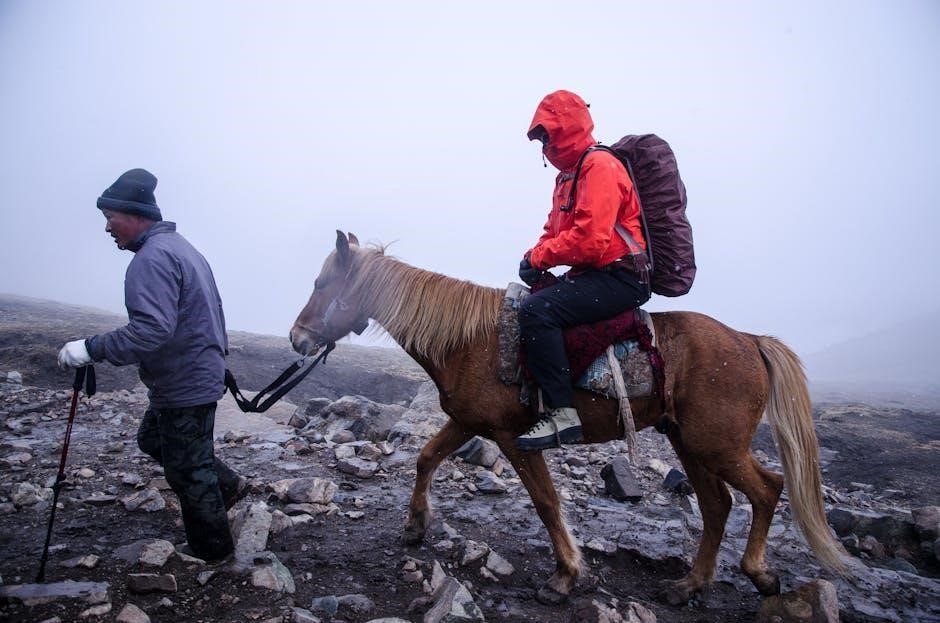
Blanketing depends on temperature, coat type, and individual needs. Generally, horses need blankets below 50°F, especially if clipped or lacking shelter. Monitor comfort and adjust as conditions change.
Temperature Guidelines
Temperature plays a crucial role in deciding when to blanket your horse. Generally, horses with natural coats do not need blanketing above 50°F, especially if they have access to shelter. Between 40-50°F, a lightweight blanket may be necessary, depending on the horse’s individual needs and coat type. Below 40°F, especially for clipped horses, a heavier blanket is recommended to provide adequate warmth. It’s important to monitor your horse’s comfort and adjust the blanket accordingly. Avoid over-blanketing, as this can lead to sweating and discomfort. Always ensure the blanket fits properly and allows for freedom of movement. Checking your horse’s condition under the blanket regularly can help prevent overheating or chilling. By following these temperature guidelines, you can ensure your horse stays comfortable and protected during colder months.
Clipped vs. Unclipped Horses
Clipped and unclipped horses have different blanketing needs due to their coat lengths. Unclipped horses with natural winter coats typically require less blanketing, as their thick fur provides insulation. However, clipped horses lose this natural protection and often need more coverage to stay warm. For unclipped horses, blanketing is usually necessary only in extreme cold, while clipped horses may need blankets even at milder temperatures. The decision also depends on the horse’s lifestyle and environment. For example, a clipped horse in outdoor turnout may require a heavier blanket to shield against wind and rain, whereas an unclipped horse in a sheltered area might need only a lightweight blanket. Always consider the horse’s individual comfort and adjust the blanket accordingly to prevent overheating or chilling. Proper blanketing ensures both clipped and unclipped horses remain comfortable and healthy throughout the colder months;
Special Situations
Special situations require tailored blanketing approaches to ensure your horse’s comfort and health. For example, senior horses or those with medical conditions may need extra warmth or specific materials to prevent discomfort. Horses that have been recently clipped or are underweight might require heavier blankets to compensate for lost insulation. Additionally, horses recovering from illness or surgery may benefit from therapeutic blankets designed to provide support or warmth. Always monitor your horse’s behavior and physical condition, as some may react differently to blanketing due to pain or sensitivity. In cases of extreme weather, such as heavy rain or freezing temperatures, extra layers or waterproof blankets may be necessary. Remember, every horse is unique, and their blanketing needs should be adjusted accordingly to prevent overheating or chilling. Consulting a veterinarian can provide personalized advice for horses with specific challenges or needs.
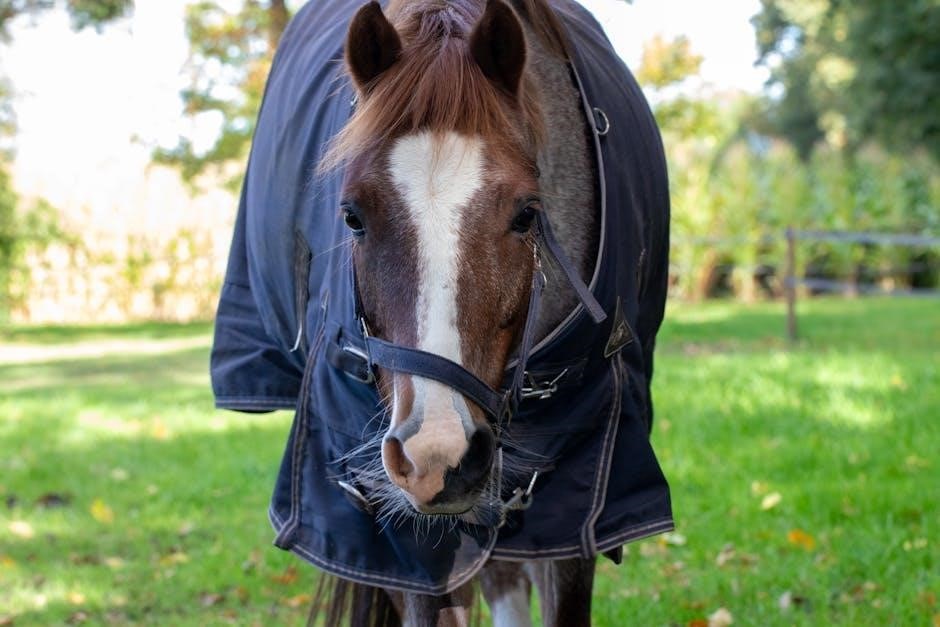
How to Properly Use and Fit a Horse Blanket
Place the blanket gently over your horse’s back, ensuring it doesn’t inhibit shoulder movement. Adjust straps to fit snugly but not too tight, avoiding pressure on the withers.

Putting on the Blanket
When putting on a horse blanket, start by approaching your horse calmly to avoid startling them. Gently place the blanket over their back, ensuring it lies flat and even. Allow the horse to see the blanket as you approach, and move slowly to prevent any sudden reactions. Position the blanket so it aligns with the horse’s natural posture, with the neckline sitting comfortably and not restricting movement. Guide the blanket over the withers and down the sides, ensuring the straps and buckles are correctly aligned. Fasten the chest straps securely but not too tightly, and adjust the belly straps to prevent shifting. Finally, check the blanket’s fit by running your hand under it to ensure it doesn’t feel too tight or restrictive. Always monitor your horse’s behavior after blanketing to ensure comfort and proper fit.
Adjusting the Fit

Adjusting the fit of a horse blanket is crucial for your horse’s comfort and safety. Start by ensuring the blanket lies flat and evenly across the horse’s back, with no bunching or twisting. The neckline should sit comfortably, allowing for free movement of the shoulders and neck. Check that the blanket does not restrict the horse’s ability to move naturally, especially during exercise or grazing. Adjust the chest straps so they are snug but not tight, ensuring the blanket stays in place without applying pressure. The belly straps should also be tightened securely to prevent shifting, but avoid over-tightening, which can cause discomfort. Regularly inspect the fit, especially after exercise or in changing weather conditions, to ensure the blanket remains comfortable and properly positioned. A well-fitted blanket prevents chafing, rubbing, and restricted movement, ensuring your horse stays comfortable and protected.
Caring for Horse Blankets
Regular cleaning and proper storage are essential for maintaining horse blankets. Wash them seasonally, using mild detergents, and store in a dry, clean area to prevent damage and odors.
Cleaning and Washing
Proper cleaning and washing of horse blankets are essential to maintain their quality and your horse’s comfort. Start by brushing off dirt and debris. Machine wash using mild detergents, avoiding harsh chemicals that can damage materials or irritate your horse’s skin. Avoid using fabric softeners, as they can reduce the blanket’s breathability. For heavily soiled areas, spot clean with a gentle soap before washing. Ensure blankets are completely dry before storage to prevent mold and mildew. Regular washing helps remove sweat and bacteria, keeping the blanket fresh and hygienic. Always follow the manufacturer’s care instructions for specific materials, such as waterproof or thermal blankets. Proper care extends the life of the blanket and ensures it continues to protect and comfort your horse effectively.

Storage and Maintenance
Proper storage and maintenance of horse blankets are crucial to preserve their quality and longevity. Always clean and dry blankets thoroughly before storing to prevent mold and mildew. Store them in a cool, dry, and well-ventilated area, away from direct sunlight and pests. Use breathable storage bags or containers to maintain airflow and protect against dust. Avoid folding blankets for extended periods, as this can cause creases and damage. Inspect blankets regularly for tears or worn areas and repair them promptly to prevent further deterioration. Proper storage ensures blankets remain in good condition for future use. Additionally, consider organizing blankets by size, weight, and type for easy access during different seasons. Regular maintenance and careful storage will extend the life of your horse blankets and ensure they continue to provide comfort and protection for your horse.
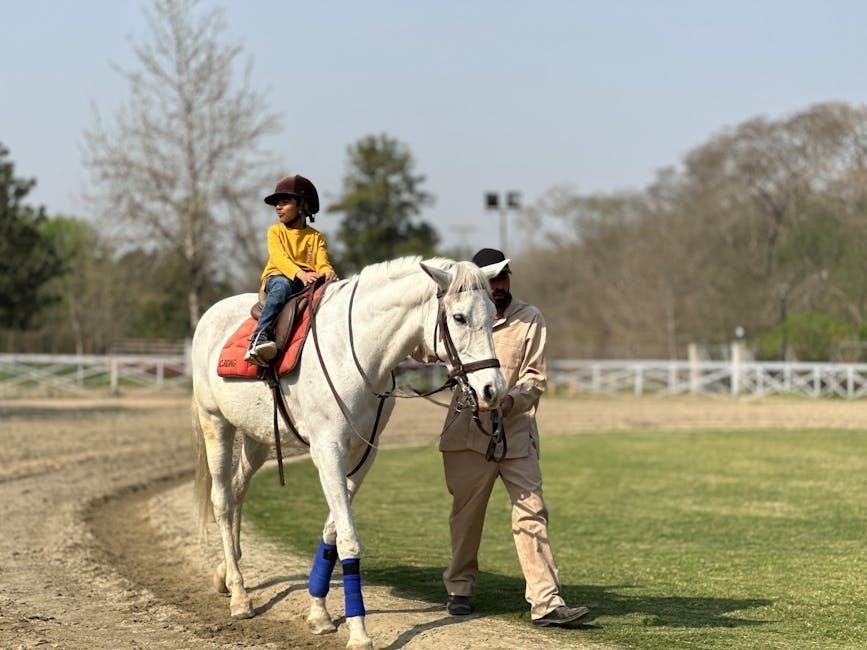
Common Mistakes to Avoid
When blanketing your horse, there are several common mistakes to avoid for optimal comfort and safety. Over-blanketing is a frequent error, as it can cause overheating and sweating, leading to discomfort and potential health issues. Using a wet or damp blanket is another mistake, as it can chill your horse and reduce the blanket’s insulating properties. Improper fit is also a concern; a blanket that is too tight or too loose can restrict movement or rub against the horse’s skin, causing irritation. Additionally, ignoring temperature guidelines and failing to adjust blankets according to weather changes can leave your horse either too cold or too hot. Lastly, not considering your horse’s individual needs, such as their coat type or living conditions, can lead to improper blanketing decisions. Avoiding these mistakes ensures your horse stays comfortable and protected.
Proper horse blanketing is essential for ensuring your horse’s comfort, protection, and overall well-being. By understanding factors like climate, coat type, and individual needs, you can make informed decisions about when and how to blanket. Choosing the right type and weight of blanket, along with ensuring a proper fit, is crucial for your horse’s health. Avoid common mistakes such as over-blanketing, using wet blankets, or ignoring temperature guidelines. Regularly monitor your horse’s condition and adjust their blanketing accordingly. With careful consideration and attention to detail, you can provide your horse with the care they need to stay comfortable and thrive throughout the year.